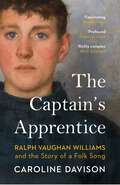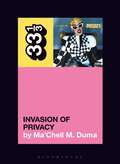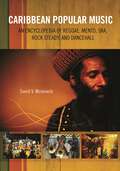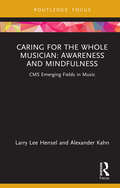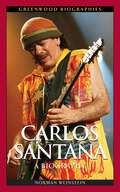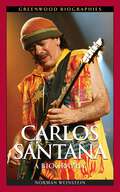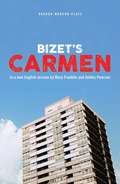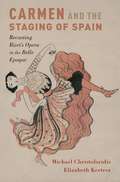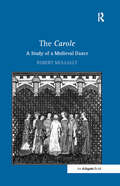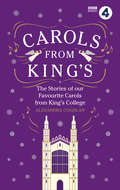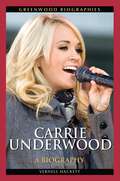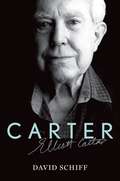- Table View
- List View
The Captain's Apprentice: Ralph Vaughan Williams and the Story of a Folk Song
by Caroline DavisonA beautifully written exploration of the world of Edwardian folk music, and its influence on the composer Ralph Vaughan WilliamsIn January 1905 the young Vaughan Williams, not yet one of England's most famous composers, visited King's Lynn, Norfolk, to find folk songs 'from the mouths of the singers'. He had started collecting in earnest little more than a year before but was now obsessed with saving these indigenous tunes before they were lost forever. An old fisherman, James 'Duggie' Carter, performed 'The Captain's Apprentice', a brutal tale of torture sung to the most beautiful tune the young composer had ever heard.The Captain's Apprentice is the story of how this mysterious song 'opened the door to an entirely new world of melody, harmony and feeling' for Vaughan Williams. With this transformational moment at its heart, the book traces the contrasting lives of the well-to-do composer and a forgotten King's Lynn cabin boy who died at sea, and brings fresh perspectives on Edwardian folk-song collectors, the singers and their songs.While exploring her own connections to folk song, via a Hebridean ancestor, a Scottish ballad learnt as a child and memories of family sing-songs, the author makes the unexpected discovery that Vaughan Williams has been a hidden influence on her musical life from the beginning - an experience she shares with generations of twentieth-century British schoolchildren.Published for Vaughan Williams's 150th birthday in August, this evocative, sensitive look at the great composer will also be read on BBC Radio 4. 'No stone is left unturned in the meticulous gathering. Her gift is a work of love and infinite care' - KEGGIE CAREW'I thoroughly enjoyed this book, and its weaving of biography, social history and folk song.' - STEVE ROUD
Cardi B's Invasion of Privacy (33 1/3)
by Ma’Chell M. DumaThe apex of critical praise and commercial success is a metric achieved by a select few. In 2020, Cardi B became synonymous with “record breaking” as her debut album Invasion of Privacy went five times platinum and became the longest charting record by a female rapper in history. From streaming and charting to views, likes, retweets, and shares, Cardi dominates. Cardi B's ascension to stardom is pure 21st century: from welfare kid to unapologetic stripper; reality TV persona, to social media maven, to a household name delivering one of the consummately executed albums in rap history, it's easy to imagine future critics noting popular music as before and after the rise of Cardi B.This in-depth look at Invasion of Privacy explores the sexual politics of hip hop through a track-by-track breakdown of the album. It addresses questions like: How does the wage gap impact pop music? Has Cardi destigmatized sex work for artists? What would hip hop look like as a matriarchy? Each chapter explores the musicality and social constructs that shape the album and a new movement in femme rap.
Cardi B's Invasion of Privacy (33 1/3)
by Ma’Chell M. DumaThe apex of critical praise and commercial success is a metric achieved by a select few. In 2020, Cardi B became synonymous with “record breaking” as her debut album Invasion of Privacy went five times platinum and became the longest charting record by a female rapper in history. From streaming and charting to views, likes, retweets, and shares, Cardi dominates. Cardi B's ascension to stardom is pure 21st century: from welfare kid to unapologetic stripper; reality TV persona, to social media maven, to a household name delivering one of the consummately executed albums in rap history, it's easy to imagine future critics noting popular music as before and after the rise of Cardi B.This in-depth look at Invasion of Privacy explores the sexual politics of hip hop through a track-by-track breakdown of the album. It addresses questions like: How does the wage gap impact pop music? Has Cardi destigmatized sex work for artists? What would hip hop look like as a matriarchy? Each chapter explores the musicality and social constructs that shape the album and a new movement in femme rap.
Caribbean Popular Music: An Encyclopedia of Reggae, Mento, Ska, Rock Steady, and Dancehall (Non-ser.)
by David V. MoskowitzReggae music is more than just steel drum bands on white sand beaches. Its history is rich with culture and evolution, helping to tell the story of Jamaica's past. Due to its depth and extensive coverage, this book is the most complete and up to date encyclopedia about reggae, mento, ska, rocksteady, and dancehall music on the market today. Ideal for reggae lovers and college students studying music, this encyclopedia is comprehensive for high school students and non-music students as well. From Bob Marley to Wayne Wonder, this easy to use encyclopedia contains over 700 entries. Indices in both the front and back of the book make navigating through entries extremely user-friendly.Entries cover singers and songwriters, producers, record labels, and different styles of music that evolved from reggae. Moskowitz truly captures the history and evolution of Jamaican music in this extensive, illuminating encyclopedia, while all the while making it accessible to both high school and college students.
Caring for the Whole Musician: CMS Emerging Fields in Music (CMS Emerging Fields in Music)
by Larry Lee Hensel Alexander KahnCaring for the Whole Musician brings together insights from two expert musicians and educators to consider the relationship between mental and physical health and artistic practice for musicians. Offering a holistic perspective that encompasses the whole being – body, mind, and heart – this book provides emerging musicians with tools, practices, and mindsets to address key challenges throughout their journey.The first part, Awareness, addresses wellness and embodiment in music, exploring how our bodies are constructed and how the use of our bodies as instruments affects function. Using approaches including Body Mapping and the Alexander Technique, this part helps readers discover adverse habits that interfere with natural movement, and nurture awareness of the body. The second part, Mindfulness, explores how meditative practice can be incorporated into every stage of concert preparation and embedded within the daily life of the musician. Offering mindfulness exercises related to each stage of the music-making process, these chapters provide strategies for readers to enhance their well-being and focus.Centered in the understanding of the musician as a whole being, this book provides an essential guide to how practices of awareness and mindfulness can allow musicians to better care for themselves and flourish in their artistic careers.
Caring for the Whole Musician: CMS Emerging Fields in Music (CMS Emerging Fields in Music)
by Larry Lee Hensel Alexander KahnCaring for the Whole Musician brings together insights from two expert musicians and educators to consider the relationship between mental and physical health and artistic practice for musicians. Offering a holistic perspective that encompasses the whole being – body, mind, and heart – this book provides emerging musicians with tools, practices, and mindsets to address key challenges throughout their journey.The first part, Awareness, addresses wellness and embodiment in music, exploring how our bodies are constructed and how the use of our bodies as instruments affects function. Using approaches including Body Mapping and the Alexander Technique, this part helps readers discover adverse habits that interfere with natural movement, and nurture awareness of the body. The second part, Mindfulness, explores how meditative practice can be incorporated into every stage of concert preparation and embedded within the daily life of the musician. Offering mindfulness exercises related to each stage of the music-making process, these chapters provide strategies for readers to enhance their well-being and focus.Centered in the understanding of the musician as a whole being, this book provides an essential guide to how practices of awareness and mindfulness can allow musicians to better care for themselves and flourish in their artistic careers.
Carlos Chavez: A Guide to Research
by Robert L. ParkerFirst Published in 1998.The purpose of this volume is to list as completely as possible Chávez’s compositions, which number close to two hundred works, and to present a digest of selected literature germane to his multi-faceted professional activity. This literature, which began in the 1920s and continues to grow, is almost entirely in Spanish and English, reflecting the main arenas in which he worked—Mexico, other Hispanic language countries, the United States, and England. Each research guide offers a selective, annotated list of writings, in all European languages, about one or more composers. There are also lists of works by the composer, unless these are available elsewhere. Biographical sketches and guides to library resources, organizations, and specialists are presented. As appropriate to the individual composer, there are maps, photographs, or other illustrative matter, glossaries, and indexes.
Carlos Chavez: A Guide to Research
by Robert L. ParkerFirst Published in 1998.The purpose of this volume is to list as completely as possible Chávez’s compositions, which number close to two hundred works, and to present a digest of selected literature germane to his multi-faceted professional activity. This literature, which began in the 1920s and continues to grow, is almost entirely in Spanish and English, reflecting the main arenas in which he worked—Mexico, other Hispanic language countries, the United States, and England. Each research guide offers a selective, annotated list of writings, in all European languages, about one or more composers. There are also lists of works by the composer, unless these are available elsewhere. Biographical sketches and guides to library resources, organizations, and specialists are presented. As appropriate to the individual composer, there are maps, photographs, or other illustrative matter, glossaries, and indexes.
Carlos Chávez and His World
by Leonora SaavedraCarlos Chávez (1899–1978) is the central figure in Mexican music of the twentieth century and among the most eminent of all Latin American modernist composers. An enfant terrible in his own country, Chávez was an integral part of the emerging music scene in the United States in the 1920s. His highly individual style—diatonic, dissonant, contrapuntal—addressed both modernity and Mexico's indigenous past. Chávez was also a governmental arts administrator, founder of major Mexican cultural institutions, and conductor and founder of the Orquesta Sinfónica de México. Carlos Chávez and His World brings together an international roster of leading scholars to delve into not only Chávez’s music but also the history, art, and politics surrounding his life and work.Contributors explore Chávez’s vast body of compositions, including his piano music, symphonies, violin concerto, late compositions, and Indianist music. They look at his connections with such artistic greats as Aaron Copland, Miguel Covarrubias, Henry Cowell, Silvestre Revueltas, and Paul Strand. The essays examine New York’s modernist scene, Mexican symphonic music, portraits of Chávez by major Mexican artists of the period, including Diego Rivera and Rufino Tamayo, and Chávez’s impact on El Colegio Nacional. A quantum leap in understanding Carlos Chávez and his milieu, this collection will stimulate further work in Latin American music and culture.The contributors are Ana R. Alonso-Minutti, Amy Bauer, Leon Botstein, David Brodbeck, Helen Delpar, Christina Taylor Gibson, Susana González Aktories, Anna Indych-López, Roberto Kolb-Neuhaus, James Krippner, Rebecca Levi, Ricardo Miranda, Julián Orbón, Howard Pollack, Leonora Saavedra, Antonio Saborit, Stephanie Stallings, and Luisa Vilar Payá.Bard Music Festival 2015:Carlos Chávez and His WorldBard CollegeAugust 7-9 and August 14-16, 2015
Carlos Chávez and His World (PDF)
by Leonora SaavedraCarlos Chávez (1899–1978) is the central figure in Mexican music of the twentieth century and among the most eminent of all Latin American modernist composers. An enfant terrible in his own country, Chávez was an integral part of the emerging music scene in the United States in the 1920s. His highly individual style—diatonic, dissonant, contrapuntal—addressed both modernity and Mexico's indigenous past. Chávez was also a governmental arts administrator, founder of major Mexican cultural institutions, and conductor and founder of the Orquesta Sinfónica de México. Carlos Chávez and His World brings together an international roster of leading scholars to delve into not only Chávez’s music but also the history, art, and politics surrounding his life and work.Contributors explore Chávez’s vast body of compositions, including his piano music, symphonies, violin concerto, late compositions, and Indianist music. They look at his connections with such artistic greats as Aaron Copland, Miguel Covarrubias, Henry Cowell, Silvestre Revueltas, and Paul Strand. The essays examine New York’s modernist scene, Mexican symphonic music, portraits of Chávez by major Mexican artists of the period, including Diego Rivera and Rufino Tamayo, and Chávez’s impact on El Colegio Nacional. A quantum leap in understanding Carlos Chávez and his milieu, this collection will stimulate further work in Latin American music and culture.The contributors are Ana R. Alonso-Minutti, Amy Bauer, Leon Botstein, David Brodbeck, Helen Delpar, Christina Taylor Gibson, Susana González Aktories, Anna Indych-López, Roberto Kolb-Neuhaus, James Krippner, Rebecca Levi, Ricardo Miranda, Julián Orbón, Howard Pollack, Leonora Saavedra, Antonio Saborit, Stephanie Stallings, and Luisa Vilar Payá.Bard Music Festival 2015:Carlos Chávez and His WorldBard CollegeAugust 7-9 and August 14-16, 2015
Carlos Santana: A Biography (Greenwood Biographies)
by Norman WeinsteinAs eclectic and paradoxical as its subject, this is the first and only book about Carlos Santana that reveals the full sweep of his musical odyssey.Carlos Santana: A Biography explores the life and music of this extraordinary guitarist, ranging from his professional beginnings—his first regular gig was at a Tijuana strip club—and early success in San Francisco to the definitive songs and albums of the 1970s, the commercial resurgence with 1999's Supernatural, his induction into the Rock and Roll Hall of Fame, and his current work with producer Bill Laswell.Unlike other biographies, this book offers a comprehensive look at Santana's transitions through a variety of musical styles beyond rock, including blues, salsa, jazz, and world music. It also portrays Santana as very much a child of the eclectic musical culture of the 1960s, as well as showing the profound influence of the New Age movement on Santana's life and music.
Carlos Santana: A Biography (Greenwood Biographies)
by Norman WeinsteinAs eclectic and paradoxical as its subject, this is the first and only book about Carlos Santana that reveals the full sweep of his musical odyssey.Carlos Santana: A Biography explores the life and music of this extraordinary guitarist, ranging from his professional beginnings—his first regular gig was at a Tijuana strip club—and early success in San Francisco to the definitive songs and albums of the 1970s, the commercial resurgence with 1999's Supernatural, his induction into the Rock and Roll Hall of Fame, and his current work with producer Bill Laswell.Unlike other biographies, this book offers a comprehensive look at Santana's transitions through a variety of musical styles beyond rock, including blues, salsa, jazz, and world music. It also portrays Santana as very much a child of the eclectic musical culture of the 1960s, as well as showing the profound influence of the New Age movement on Santana's life and music.
Carmen: As Produced At The Manhattan Opera House Under The Direction Of Oscar Hammerstein (classic Reprint) (Oberon Modern Plays)
by Georges BizetThe Olivier Award nominated producers of La Traviata, La bohème and Tosca present a vivid, compelling and devastatingly powerful take on Georges Bizet’s masterpiece. Carmen works minimum wage jobs on the frontline of Britain’s crumbling service industry. Jose falls madly in love with her after a brief fling. As his passion morphs into something uglier, and far more troubling, Carmen realises she might have made a fatal mistake… Sung in English, and blending stark emotional realism with some of the world’s most beloved music, this highly original new production examines toxic relationships in a society on the brink of collapse.
Carmen and the Staging of Spain: Recasting Bizet's Opera in the Belle Epoque (Currents in Latin American and Iberian Music)
by Michael Christoforidis Elizabeth KerteszCarmen and the Staging of Spain explores the Belle Époque fascination with Spanish entertainment that refashioned Bizet's opera and gave rise to an international "Carmen industry." Authors Michael Christoforidis and Elizabeth Kertesz challenge the notion of Carmen as an unchanging exotic construct, tracing the ways in which performers and productions responded to evolving fashions for Spanish style from its 1875 premiere to 1915. Focusing on selected realizations of the opera in Paris, London and New York, Christoforidis and Kertesz explore the cycles of influence between the opera and its parodies; adaptations in spoken drama, ballet and film; and the panorama of flamenco, Spanish dance, and musical entertainments. Their findings also uncover Carmen's dynamic interaction with issues of Hispanic identity against the backdrop of Spain's changing international fortunes. The Spanish response to this now most-Spanish of operas is illuminated by its early reception in Madrid and Barcelona, adaptations to local theatrical genres, and impact on Spanish composers of the time. A series of Spanish Carmens, from opera singers Elena Sanz and Maria Gay to the infamous music-hall star La Belle Otero, had a crucial influence on the interpretation of the title role. Their stories provide a fresh context for the book's reappraisal of leading Carmens of the era, including Emma Calvé and Geraldine Farrar.
Carmen and the Staging of Spain: Recasting Bizet's Opera in the Belle Epoque (Currents in Latin American and Iberian Music)
by Michael Christoforidis Elizabeth KerteszCarmen and the Staging of Spain explores the Belle Époque fascination with Spanish entertainment that refashioned Bizet's opera and gave rise to an international "Carmen industry." Authors Michael Christoforidis and Elizabeth Kertesz challenge the notion of Carmen as an unchanging exotic construct, tracing the ways in which performers and productions responded to evolving fashions for Spanish style from its 1875 premiere to 1915. Focusing on selected realizations of the opera in Paris, London and New York, Christoforidis and Kertesz explore the cycles of influence between the opera and its parodies; adaptations in spoken drama, ballet and film; and the panorama of flamenco, Spanish dance, and musical entertainments. Their findings also uncover Carmen's dynamic interaction with issues of Hispanic identity against the backdrop of Spain's changing international fortunes. The Spanish response to this now most-Spanish of operas is illuminated by its early reception in Madrid and Barcelona, adaptations to local theatrical genres, and impact on Spanish composers of the time. A series of Spanish Carmens, from opera singers Elena Sanz and Maria Gay to the infamous music-hall star La Belle Otero, had a crucial influence on the interpretation of the title role. Their stories provide a fresh context for the book's reappraisal of leading Carmens of the era, including Emma Calvé and Geraldine Farrar.
The Carole: A Study of a Medieval Dance
by Robert MullallyThe carole was the principal social dance in France and England from c. 1100 to c. 1400 and was frequently mentioned in French and English medieval literature. However, it has been widely misunderstood by contributors in recent citations in dictionaries and reference books, both linguistic and musical. The carole was performed by all classes of society - kings and nobles, shepherds and servant girls. It is described as taking place both indoors and outdoors. Its central position in the life of the people is underlined by references not only in what we might call fictional texts, but also in historical (or quasi-historical) writings, in moral treatises and even in a work on astronomy. Dr Robert Mullally's focus is very much on details relevant to the history, choreography and performance of the dance as revealed in the primary sources. This methodology involves attempting to isolate the term carole from other dance terms not only in French, but also in other languages. Mullally's groundbreaking study establishes all the characteristics of this dance: etymological, choreographical, lyrical, musical and iconographical.
The Carole: A Study of a Medieval Dance
by Robert MullallyThe carole was the principal social dance in France and England from c. 1100 to c. 1400 and was frequently mentioned in French and English medieval literature. However, it has been widely misunderstood by contributors in recent citations in dictionaries and reference books, both linguistic and musical. The carole was performed by all classes of society - kings and nobles, shepherds and servant girls. It is described as taking place both indoors and outdoors. Its central position in the life of the people is underlined by references not only in what we might call fictional texts, but also in historical (or quasi-historical) writings, in moral treatises and even in a work on astronomy. Dr Robert Mullally's focus is very much on details relevant to the history, choreography and performance of the dance as revealed in the primary sources. This methodology involves attempting to isolate the term carole from other dance terms not only in French, but also in other languages. Mullally's groundbreaking study establishes all the characteristics of this dance: etymological, choreographical, lyrical, musical and iconographical.
Carole King's Tapestry (33 1/3)
by Loren GlassCarole King's Tapestry is both an anthemic embodiment of second-wave feminism and an apotheosis of the Laurel Canyon singer-songwriter sound and scene. And these two elements of the album's historic significance are closely related insofar as the professional autonomy of the singer-songwriter is an expression of the freedom and independence women of King's generation sought as the turbulent sixties came to a close.Aligning King's own development from girl to woman with the larger shift in the music industry from teen-oriented singles by girl groups to albums by adult-oriented singer-songwriters, this volume situates Tapestry both within King's original vision as the third in a trilogy (preceded by Now That Everything's Been Said and Writer) and as a watershed in musical and cultural history, challenging the male dominance of the music and entertainment industries and laying the groundwork for female dominated genres such as women's music and Riot Grrrl punk.
Carole King's Tapestry (33 1/3 #153)
by Loren GlassCarole King's Tapestry is both an anthemic embodiment of second-wave feminism and an apotheosis of the Laurel Canyon singer-songwriter sound and scene. And these two elements of the album's historic significance are closely related insofar as the professional autonomy of the singer-songwriter is an expression of the freedom and independence women of King's generation sought as the turbulent sixties came to a close.Aligning King's own development from girl to woman with the larger shift in the music industry from teen-oriented singles by girl groups to albums by adult-oriented singer-songwriters, this volume situates Tapestry both within King's original vision as the third in a trilogy (preceded by Now That Everything's Been Said and Writer) and as a watershed in musical and cultural history, challenging the male dominance of the music and entertainment industries and laying the groundwork for female dominated genres such as women's music and Riot Grrrl punk.
Carols From King's
by Alexandra CoghlanThe exquisite sound of a lone chorister singing Once in Royal David’s City amid the candlelit chapel of King’s College, Cambridge, marks the start of the Christmas festivities for millions of people round the globe. Broadcast at 3pm on Christmas Eve, A Festival of Nine Lessons and Carols provides a precious moment of tranquillity amongst the bustle of the festive season. Take a journey through the fascinating history of carols, from the very first - sung by the angels to the shepherds at Bethlehem - to anecdotes from contemporary King's choristers. Learn how carols have evolved from pagan songs to become one of our nation's most sacred treasures. Accompanied by lyrics and music and compiled in conjunction with Radio 4 and King’s College Chapel, Carols From King’s is the official companion for fans of Christmas and carols alike.
Carrie Underwood: A Biography (Greenwood Biographies)
by Vernell HackettIn this book, follow the career of Carrie Underwood as she goes from the American Idol competition to worldwide celebrity.Carrie Underwood: A Biography follows the singer from a small town in Oklahoma to the stages of the most prestigious concert halls in the world. Along the way, fans will read about this girl-next-door's decision to compete on American Idol and her subsequent triumph there, about her first recordings in Nashville and her platinum albums, and about her sold-out concert tours with superstars like Brad Paisley, Kenny Chesney, and Keith Urban.But the book isn't only about Underwood as a celebrity. It is also about how she uses that celebrity to do good works, including speaking out for the Humane Society of the United States, participating in a song that benefited Stand Up For Cancer, doing public service announcements for the Do Something youth organization, and touring for the USO.
Carrie Underwood: A Biography (Greenwood Biographies)
by Vernell HackettIn this book, follow the career of Carrie Underwood as she goes from the American Idol competition to worldwide celebrity.Carrie Underwood: A Biography follows the singer from a small town in Oklahoma to the stages of the most prestigious concert halls in the world. Along the way, fans will read about this girl-next-door's decision to compete on American Idol and her subsequent triumph there, about her first recordings in Nashville and her platinum albums, and about her sold-out concert tours with superstars like Brad Paisley, Kenny Chesney, and Keith Urban.But the book isn't only about Underwood as a celebrity. It is also about how she uses that celebrity to do good works, including speaking out for the Humane Society of the United States, participating in a song that benefited Stand Up For Cancer, doing public service announcements for the Do Something youth organization, and touring for the USO.
Carter (Master Musicians Series)
by David SchiffElliott Carter (1908-2012) was the foremost composer of classical music in America during the second half of the 20th century. Over the course of a career that spanned seven decades, he consistently produced works that critics hailed as creatively daring, intellectually demanding, and emotionally complex. Distancing himself from the various "schools" and movements that grew and waned in popularity during the postwar era, Carter cultivated a deeply personal musical style that he developed and refined up until the very end of his life. This book of the composer springs from author David Schiff's life-long interest in Elliott Carter's music and his close personal connection with the composer which spanned over forty years. This critical overview of Carter's life and work explores aspects of the composer's life about which he was usually reticent--and occasionally misleading--such as his complicated relationships with Charles Ives, Aaron Copland, Nicolas Nabokov, and his own parents. Schiff's study of Carter's complete oeuvre--from his politically charged Depression-era ballets to the deeply personal and reflective late works--is based on extensive study of the composer's personal sketches and letters. Featuring an in-depth look at the legacy project of Carter's final decade, seven settings of American modernist poetry by E.E. Cummings, T.S. Eliot, Marianne Moore, Ezra Pound, Wallace Stevens and William Carlos Williams, this newest addition to the Master Musicians Series paints with a fine brush the story of America's foremost composer of the second half of the twentieth century.
Carter (Master Musicians Series)
by David SchiffElliott Carter (1908-2012) was the foremost composer of classical music in America during the second half of the 20th century. Over the course of a career that spanned seven decades, he consistently produced works that critics hailed as creatively daring, intellectually demanding, and emotionally complex. Distancing himself from the various "schools" and movements that grew and waned in popularity during the postwar era, Carter cultivated a deeply personal musical style that he developed and refined up until the very end of his life. This book of the composer springs from author David Schiff's life-long interest in Elliott Carter's music and his close personal connection with the composer which spanned over forty years. This critical overview of Carter's life and work explores aspects of the composer's life about which he was usually reticent--and occasionally misleading--such as his complicated relationships with Charles Ives, Aaron Copland, Nicolas Nabokov, and his own parents. Schiff's study of Carter's complete oeuvre--from his politically charged Depression-era ballets to the deeply personal and reflective late works--is based on extensive study of the composer's personal sketches and letters. Featuring an in-depth look at the legacy project of Carter's final decade, seven settings of American modernist poetry by E.E. Cummings, T.S. Eliot, Marianne Moore, Ezra Pound, Wallace Stevens and William Carlos Williams, this newest addition to the Master Musicians Series paints with a fine brush the story of America's foremost composer of the second half of the twentieth century.
Caruso and Tetrazzini On the Art of Singing
by Luisa Tetrazzini Enrico CarusoTwo of opera's greatest names offer encouragement and useful advice to aspiring singers in this classic guide. Tenor Enrico Caruso and coloratura soprano Luisa Tetrazzini employ nontechnical terms to provide an informal vocalist's anatomy, with instructions for the proper training, care, and disposition of the tongue, lungs, diaphragm, mouth, and the voice itself.Tetrazzini deals with the foundations of singing in breath control; tone emission and attack; and, sending aspiring performers to the mirror, facial expression and dress. Caruso remarks on tone production; such faults as the "white voice" and "goat voice"; the necessity of good diction; the role of diet; and the part superstition plays in certain singers' performances. These consummate artists show great charm and presence as writers, and this little book is a great pleasure to read.
